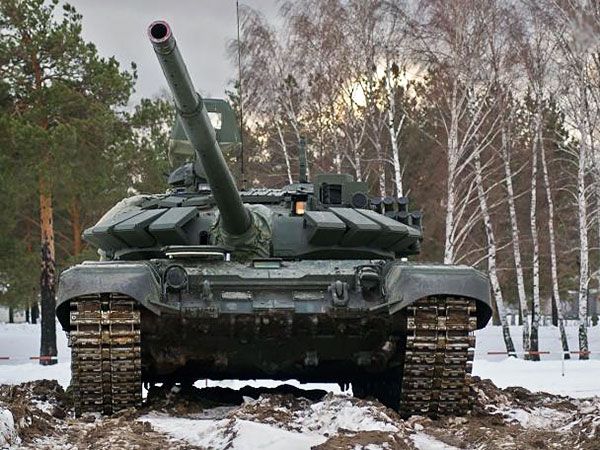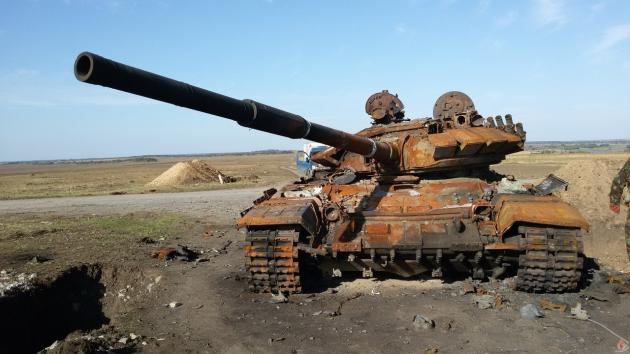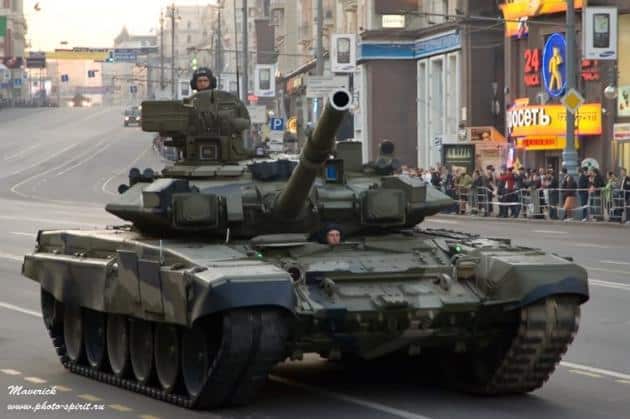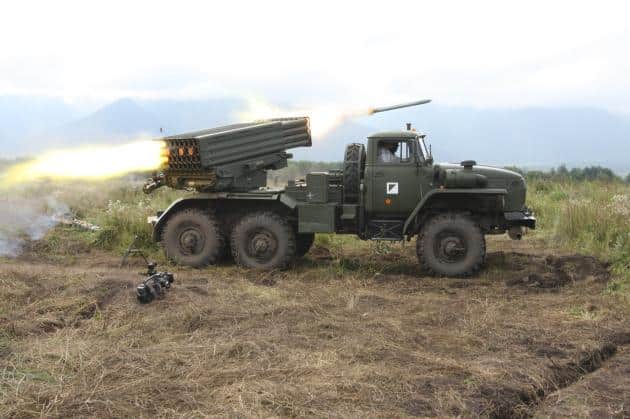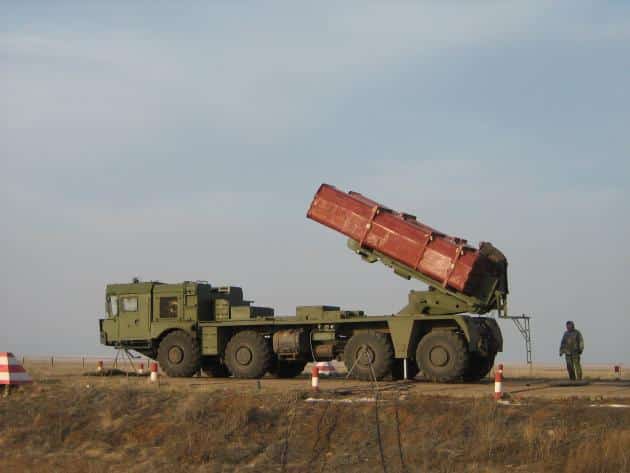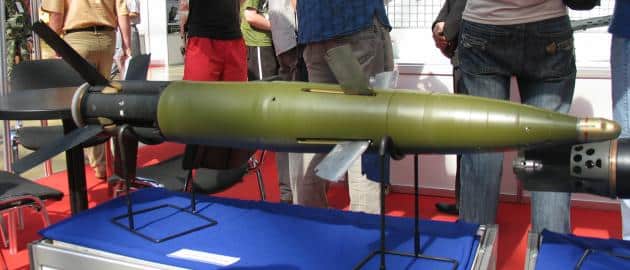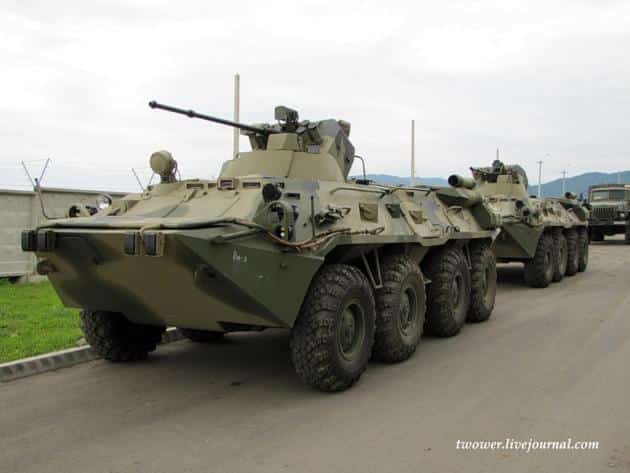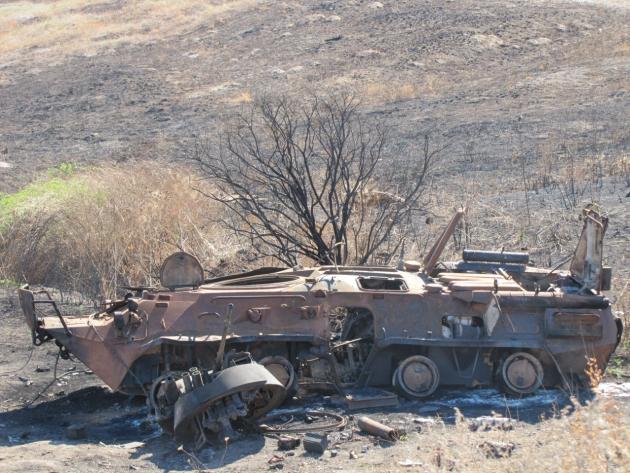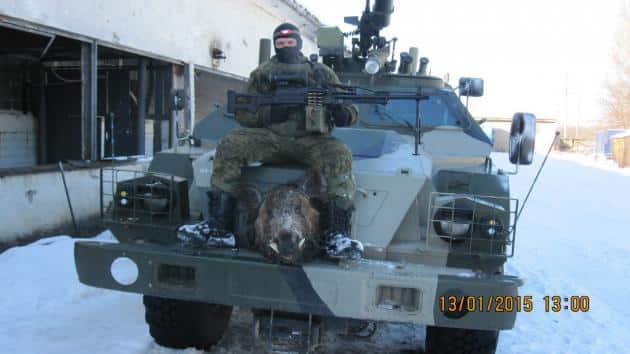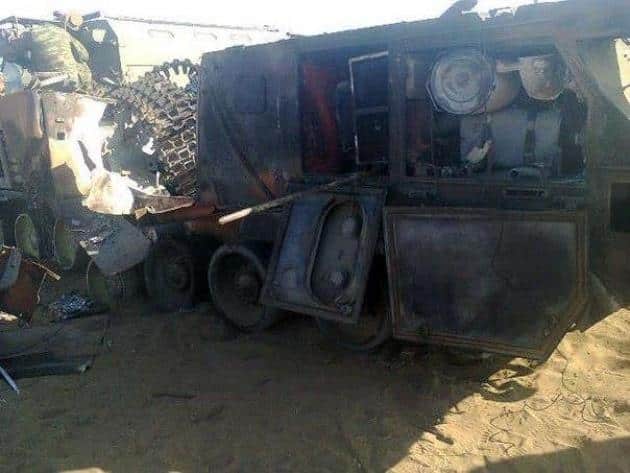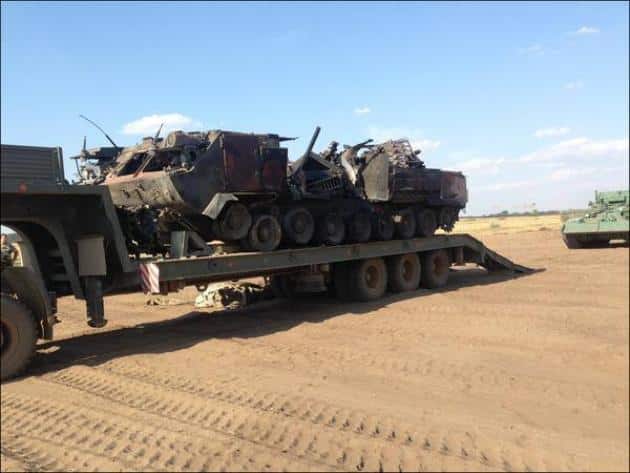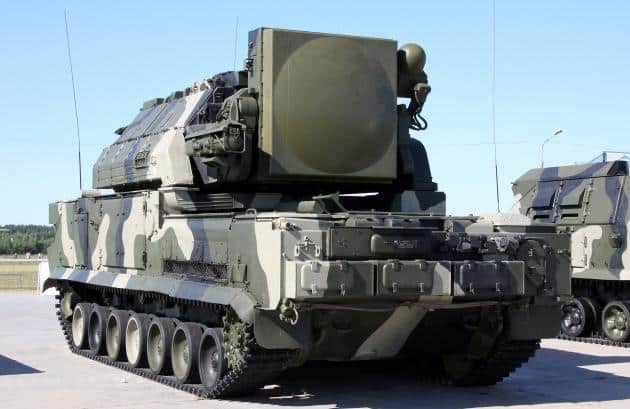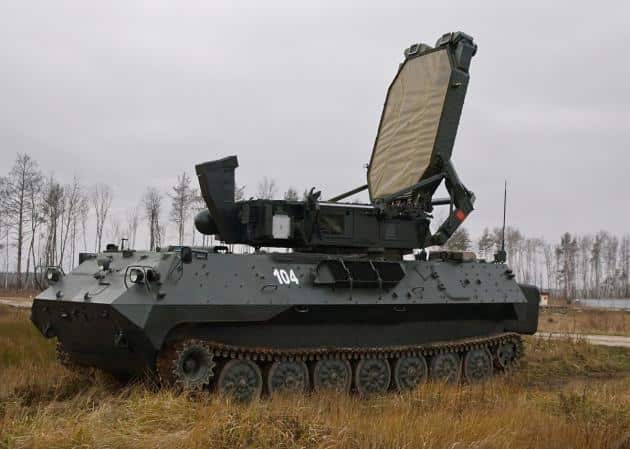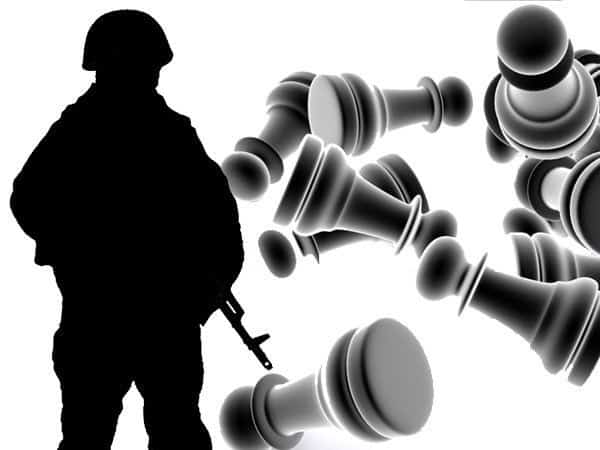Hardly anyone now doubts the fact that the militants of terrorist groups operating today in the East of our country, are armed with heavy weaponry. The method of delivering army combat equipment directly into the hands of militants is also well-known: so-called Putin “Voentorg” is running at full capacity.
Tanks, armored vehicles, artillery of various types and calibers, modern avionics and communications equipment, unmanned intelligence systems, modern infantry weapons and equipment – all this and much more form the steady flow coming from the neighboring state to the militias in need.
Moreover, the newly designed products of the Russian defense industry often get into the territory of Ukrainian Donbass along with integrated subdivisions of regular Russian army, disguised as “another batch of volunteers” or soldiers from Rostov polygons, “accidentally lost” in the steppes of Donbass. Therefore, it would be appropriate to take a closer look at what today’s aggressor is armed with. The knowledge of enemy’s weapons can help our military to find ways to effectively combat.
Armored fists of terrorist
Of course, a significant part of terrorists’ military equipment is well-known for Ukrainian servicemen. After all, until recently, the armed forces of both Ukraine and Russia possessed the same Soviet weapons. The significant resources of those are still available. Therefore there is nothing surprising in the fact that both parties of the conflict actively use Soviet war equipment.
However, the growing number of new and upgraded models appeared at the disposal of Russian-terrorist groups in the recent years. The powerful stream of modern weapons, now developed and made exclusively in Russia, is flowing to Donbass terrorists. And the flow is increasing.
Over the last decade, as a result of the militarization of the country and getting super-profits from trading oil and gas, leadership of the Russian Federation invested a lot of money into army modernization. Therefore, it is no coincidence that new models of weapons and military equipment first came to the Russian military, and then – to pro-Russian terrorist groups. We’ll discuss those new models in more detail…
The terrorist task force in Donbass is based on armored military unit. Mainly the various modifications of the tank T-64 were supplied by the current Kremlin regime to its followers at the initial phase of the aggression. In order to “disguise” their assistance to terrorists, leadership of the Russian Federation used this tank, knowing very well that in the Armed Forces of Ukraine this is the main battle tank (it had been phased out in Russia long time ago). But the time came and Russian tank reserves ran out of well-known in Ukraine “Kharkov sixty-fours”. Moreover: faced on the battlefield with last Ukrainian model of the tank, T-64 BM “Bulat”, which has significant advantages over the old model, the Russian command has come to the conclusion that it is time “to put to use” their new developments, that are no worse than Ukrainian.
So modernized Russian tanks T-72, T-72BA and T-72B3 appeared in the Donbass. The first case of mass use of these tanks was the battle near Debaltseve with the participation of military personnel of 5th Armored Brigade and Kantemir Division of the Russian Army. Also several units of T-90 (which is a highly modernized version of T-72) were noted in Donbass later. Since the main characteristics of the T-72 and peculiarities of its construction are well-known in Ukraine, we shall not discuss those here. Instead we’ll describe some features of T-72B3 and T-90, because they may become the future basis of armored forces of insurgents.
This is T-72B3 (2011) – an upgraded version of the T-72. It became available for the armed forces of the Russian Federation in 2012. The tank has a new fire control system, the dynamic protection system “Contact-5”, 840 horsepower engine B-84-1, multi-channel gunner’s sight “Sosna-U”, wind sensor, advanced communications, improved arms stabilizer and system of protection against weapons of mass destruction. Ukrainian troopers noted a considerable distance – up to 2000 meters, from which this tank can fire new ammunition “Lead-1 \ 2” at night, attributed to the presence of thermal imaging channel in the sight “Sosna-U” and laser target tracking. The automatic gun loading and chassis that now have parallel hinge caterpillar tracks are among the other improved features. The latest modification of the T-72B3 (2014) has 1130 horsepower engine.
T-90A / T-90 “Vladimir” – a Russian main battle tank. Created in the late 1980s – early 1990s as a highly modernized T-72B tank, it was initially called “T-72B advanced”, but it was renamed to T-90 later, in 1992. In 2004-2006, the tank was significantly upgraded and its production for the Russian Armed Forces started under the name T-90A. Totally 32 tanks of the T-90A type (model 2004) and 337 tanks of the T-90A type (model 2006) were produced during 2004 – 2011, including 50 tanks T-90AK. In 2005 the T-90A was officially adopted by the Russian Armed Forces. T-90A is an upgraded version of T-90 (first named “object 188A1”), it entered production in 2004 and has a number of important improvements:
he 2004 modification has a thermal night gunner’s sight “Buran-M”, substituted in 2006 modification by a more modern electro-optical thermal sight “ESSA” based on French second-generation thermal imaging cameras «Catherine FC», stabilized in two planes, integrated with main sight as well as with distance measuring channel, which increased night vision range from 1800 to 4000 m (the Ukrainian military could feel that during Debaltsevo battles);
– former cast turret is now replaced by a reinforced welded one with frontal clearance up to 950 mm, which significantly increased its stability, including stability against the so-called “tandem ammunition” and cumulative shells;
– 840-horsepower diesel engine is replaced by a 1000-horsepower V-92S2 engine; an option for installation of the 1200-horsepower diesel engine B-99 is provided; replacing the gun stabilizer doubled the guidance rate and improved accuracy of fire on the move.
According to official data, total production of T-90 and its modifications for Russian armed forces at the beginning of 2012 amounted to about 500 tanks. These particular tanks were first seen last summer in the battles for Ilovaysk and on the march in the area north than Lugansk.
Artillery curse of Donbass
As for artillery systems actively used by militants, there is a fairly large variety of styles, types and calibers. The basis of the terrorists’ artillery park consists of the systems D-20, D-30, “MSTA-B”, 2S1 “Carnation”, 2C3 “Acacia”, “MSTA-S”, multiple launch rocket systems (MLRS) type BM-21 “Grad”, BM-27 “Hurricane” and the BM-30 “Smerch”.
Also, a surge in the combat capabilities of terrorists groups definitely results from some very recent developments of the Russian defense industry handed to the terrorists by the Russian regime. I mean the new series of MLRS “Tornado” and new ammunition for the 152-mm howitzers “MSTA-S” and “MSTA-B.”
Today, thanks to the efforts of Putin’s “Voentorg”, multiple rocket launchers “Tornado” of both G- and S-types are at the disposal of terrorists. One of those systems attacked the city of Kramatorsk and the local airfield.
Tornado-G”, modernized Russian multiple launch rocket system. It was created on the basis of MLRS 9K51 “Grad”. In July 2012 the first MLRS “Tornado-G” became operational in the motorized infantry formations of the Russian army ground forces. The leadership of the Russian Defense Ministry persistently denied “adopting” the system until in 2013 system 9K51M completed state tests and was officially put into service in the Russian Federation.
The structure MLRS 9K51M includes a new upgraded combat vehicle BM-21, old and new types of 122-mm rockets and AIMS “Skit-BM”. The cockpit of combat vehicle contains remote control equipment and automated fire control system. An automated guidance system can fire without topographic preparation and does not require cabin crew to leave the cabin. Special monitor automatically displays information about the route and the position of the package guides. The crew is reduced from 3 to 2 persons, deployment time is reduced to 6 minutes for unprepared positions, and to 1 minute – for prepared positions. Combat capabilities of the new system have been expanded with new jet ammunition. Those include cluster warhead missiles, capable of separating from the carrier and self-guiding on the way to the target that allows to effectively hit enemy’s armored vehicles.
It should be emphasized that a whole “line” of new weapons has been developed for this new MLRS, including the so-called “anti-bomb-proof” missiles, capable of hitting even the depths of the enemy’s dugouts and destroying engineering facilities. The use of these weapons by militants has been repeatedly confirmed by the Ukrainian troops in the direction of Lugansk. The maximum range of the system is 100 km.
“Tornado-S” – modernized MLRS 9K58 “Smerch”. The system includes an upgraded combat vehicle equipped with the latest automated control and guidance and new guided and non-guided 300 mm missiles with a maximum range of up to 120-150 km. 9K515 MLRS “Tornado-S” three times exceeds the combat effectiveness of its predecessor MLRS “Smerch”.
This multiple launch rocket system, is provided with satellite guidance system, and its missiles have more powerful warheads compared to “Smerch”. Moreover each missile can adjust its flight path. Shells may have cluster heads filled with shrapnel, self-guided elements, special anti-tank mines or cumulative ammunition,
The fighting qualities of the new ammunition for 152 mm self-propelled howitzers “MSTA-S” and “MSTA-B”, which is reportedly used by terrorists in the ATO zone, look quite powerful.
Recall that the basic ammunition for self-propelled howitzer “MSTA-S” includes high-explosive shells 3OF45 with a maximum firing range of 24.7 km, shells 3OF64 with improved efficiency, high- explosive shells 3OF61 with the bottom gasifier and the new cluster shells 3-O-23. Ammunition allowance for this system consists of 20 high-explosive and 30 active-reactive shells.
Recent ammunitions developed for MSTS-S include adjustable shells -“Centimeter” and “Krasnopol” – to defeat armored vehicles in the areas of concentration, enemy missile launchers, long-term fortifications, bridges and ferries; also – modernized guided missiles “Krasnopol-M1” with increased range and reduced weight and size, so that they may be added to the regular combat pack of ACS. In addition, the whole range of ammunition, intended for 152-mm howitzers 2S3 and D-20 can be used.
New APC, new challenges
Besides armored vehicles and artillery u from armored combat vehicles to various electronic intelligence means, including means of artillery reconnaissance, electronic warfare and drones. Here are some examples:
Armored personnel carrier BTR-80A – a modification of BTR-80 with preservation of its major components and assemblies in its design. This type of armored combat vehicle, today is frequently used by militants. It was first noticed in the fighting for the Novosvetlovka area, south of Luhansk, where Ukrainian soldiers managed to destroy two units of this BTR.
APC is armed with turret machine gun BPPU-1, 30-mm automatic cannon 2A72 with selective delivery of ammunition, paired with 7.62-mm machine gun PKT with firing angles from -5° to + 70° vertically and 360° horizontally. The turret unit is equipped with day sight 1PZ-9, night sight TPNZ-42, projector OU-5M andsmoke grenade launching system 902V. Cannon ammunition consists of 300 rounds (two tapes of 150 pieces each); machine gun ammunition consists of 2000 rounds (in one tape). Depending on the nature and type of goals, the operator can easily select the type of ammunition and regulate the fire rate.
The effectiveness of BPPU-1 combat employment for ground targets is 2.1-2.4 times higher compared to armored vehicles with 14.5 mm machine gun; their losses from helicopters attacks are 2 times lower. The remote fire control has three firing modes: single-shot, low speed and high speed. Firepower increases due to firing from personal firearms, hand grenades and portable anti-aircraft missile systems like “Igla” or “Strela”. The battle crew, equipment, power plant and other systems are the same as on the BTR-80. Special features of the machine are associated with the use of gun-turret system. BTR-80A housing is made tougher to accomodate operation of the automatic guns and to achieve specified requirements for fire accuracy and precision. Bypass arc is installed in order to avoid a possible self-defeat.
Another type of armored vehicle used by militants, BTR-82A, is also a deep modernization of the BTR-80. Several improvements increased protection of the machine by 20% those include protection of the crew, assemblies and systems from armor-piercing bullets of weapons used by infantry in close combat at a distance of 100 meters, as well as from the secondary damages by main armor debris. Additional thermal and sound insulation of the crew compartments improves comfort inside the vehicle.
Firing power of BTR-82A has been enhanced by installing a unified fighting module with electric drive and two-plane arms stabilizer. 14.5 mm machine gun KPVT and 7.62-mm machine gun PKTM are used as the main weapons in this combat module. Ammunition supply system: for KPVT – single tape 500 cartridges, for PKTM – single tape 2000 cartridges. The unified module allows installation of other types of artillery weapons, including the ones manufactured abroad. New gunners sight TKN-4GA (and soon TKN-4GA-02) with combined round the clock action and stabilized field of view is installed in this BTR to improve intelligence capabilities and effectiveness of shooting. This increased the effectiveness of fire for BTR-82 by 2.5 times, compared to BTR-80, and allowed to use basic fire arms of the BTR at night and on the move. These exactly features of BTR-82A were massively used by terrorists during battles in the areas north of Lugansk, near the village of Metallist and in Kamenobrodsky area of the city. According to some sources, those were regular subdivisions of Russian army, disguised as the so-called militias. After all, the most militant of illegal armed groups simply did not have time to learn a new type of APC.
The machine is equipped with the new radio station R-168-25U2, topography orientation system “Throne-1” with independent and satellite navigation channels of information and commander’s combined observation device TKN-AI. TKN-AI is provided with the laser active-pulse illumination, provides more accurate distance measurement, eliminates signs of infrared illuminators and allows commander to detect enemy at distances up to 3 km.
Another Russian armored combat vehicle appeared massively in the armed groups of so-called LNR in winter of 2014-2015. That was lightly armored vehicle KAMAZ-43269 “Vystrel” (BPM-97).
It is typically used as a staff, patrol, ambulance, border, or intelligence car. “Vystrel” is assembled in Naberezhnye Chelny at the non-public stock company “Remdizel”.
Components and assemblies of KAMAZ-4326 4×4 are installed on the armored vehicle body made by the public stock company “Kurgan”. Structurally, BPM-97 is a four-wheel drive armored vehicle with the welded-on body. It is divided into the engine compartment and the compartment for the crew and troops. The main body has side and rear doors, hatches for landing troops and for mechanic. The use of standardized components and assemblies facilitates production and repair of this car, reduces its cost, and provides technical inspections and repairs by common technical equipment manufactured by the public stock company “KamAZ”. First major repair is due after 270 thousand km.
BMP-97 is equipped with two 125 liter bulletproof tanks and additional armored 20 liter tank. The upper part of the body can withstand shots from a 12.7 mm machine gun “Utjos” from 300 m, the lower part and the stern withstand shots from 7.62-mm Dragunov sniper rifle (SVD) from a distance of 30 m; vehicle has armored bottom. Various modifications allow to install a 14.5 mm machine gun KPVT, 12.7 mm machine gun “Kord”, 30-mm grenade launcher “Plamya” or an anti-tank missile system.
Russian 7th military base in Gudauta (Abkhazia) has this armored car in its inventory, it is used mostly as a reconnaissance vehicle. Some of the vehicles are equipped for launching light unmanned aircraft. This armored vehicle is widely used by special units of Russian Federal Security Service and by the border security.
The appearance of these armored vehicles in the territory of Ukraine was accompanied by massive “purges” of so-called “wild militants” and “Don Cossacks” who refused to submit to the central command of terrorists, and by the massive use of unmanned aerial vehicles by militants to the north of Lugansk.
“Smart” weapons for stupid people
Thanks to the unprecedented generosity of Putin, terrorists now have the latest means of air defense. That includes upgraded anti-aircraft missile system “Thor-M1”. Ukrainian military managed to destroy one unit of this type of self-propelled air defense system during the summer-fall fighting of 2014 in the area between Yenakiyevo and Gorlovka.
“Thor-M1” is an all-weather tactical air defense missile system, designed to meet the challenges of air and missile defense. It can work in both manual (with the participation of operators) and fully automatic mode. The system independently controls airspace and hits all the aerial targets, not recognized by radar identification system. The probability of hitting a plane target by one missile is between 30 and 77%, helicopters are hit with the probability of 50-88%, unmanned aerial vehicles – with the probability of 85-95%. “Thor-M1” provides protection against targets moving at the speeds up to 700 m / s at distances from 0.5 to 12 km and at altitudes from 10 meters to 6 km. Translation between traveling and combat configurations takes up to 3 minutes. The reaction time of the complex – 8-12 seconds.
The results of modernization are: introduction of the second target channel, more effective warhead of the surface-to-air missile, increased target hit zone, possibility of communications with the unified command post 9S737 “Rankings”. Personnel of the machine has been reduced to three (commander, operator, and driver). Number of goals that the complex is able to detect and identify, has been increased to 48. Automatic tracking feature was added to the optical guidance station to improve the accuracy of target tracking. New 9M331 missiles can withstand 30g overload and hit targets maneuvering with accelerations up to 12g. Rockets are placed in quadruple transporting and launching containers 9YA281 as opposed to launchers. Transporting and launching containers are made of aluminum alloys. Weight of one container with missiles and ejection units is only 936 kg. Transport and launch containers in packets can be moved by a transport vehicle 9T244.
The modernized complex “Tor-M1-2” is intended to replace complexes “Wasp”, “Thor” and “Tor-M1”. The first batch of “Tor-M1-2″ came to the Russian Southern Military District in November 2012. In December 2012 Izhevsk Electromechanical Plant “Kupol” was awarded a new contract for 2013 worth 5.7 billion rubles. Since then Russian army already got additional 12 combat vehicles 9A331MU, three maintenance vehicles 9V887M2U, one maintenance vehicle 9V887-1M2U, spare parts vehicle 9F339-1M2U, six of each freight loading vehicles 9T244-1 and 9T245 1, one set of ground equipment 9F116.
Another example of the Russian military asset which brought particular inconvenience for Ukrainian military in the conflict, and had been repeatedly used by the Russian- terrorist armed forces, was the radar complex “Zoo-1M”.
“Zoo-1M” is a complex radar intelligence and fire control (radar counterbattery). It is designed for reconnaissance of the enemy firing positions (MLRS, artillery and mortar positions, launchers of tactical missiles, air defense systems and others), for missiles’ trajectories calculation, for fire corrections, airspace surveillance and control of unmanned aerial vehicles.
The upgraded radar system of surveying missiles and artillery positions “Zoo-1M” was demonstrated for the first time in August 2013 by the Air Defense Concern “Almaz-Antey” at the exhibition MAKS-2013. The new complex has received an index 1L219M by the Main Missile and Artillery Directorate of the Defense Ministry (GRAU-index). First information about “Zoo” system in the Russian army appeared in the media in 2004. However, most likely, those were military trials. The completion of the tests was reported on February 19, 2008. The autonomy of the complex and its fast deployment time allow the use 1L219M in march with simultaneous deployment of weapons, which plays an important role in the introduction of reinforced subdivisions to the most vulnerable places (during peacekeeping operations, in local wars, etc.).
High-performance of both radar and computer systems allows to determine the coordinates of all fire weapons even under a massive artillery bombardment, and to automatically guide their destruction before they escape. This complex has repeatedly demonstrated its abilities in the course of counter-battery artillery fighting of militants and Russian regular troops against Ukrainian army in Donbass during summer and fall of 2014. The ability to quickly leave the position, to change radar frequency, bulletproof windows and crew protection equipment improve combat survivability of this complex.
Konstantin Mashovets, coordinator of the group “Information Resistance”

